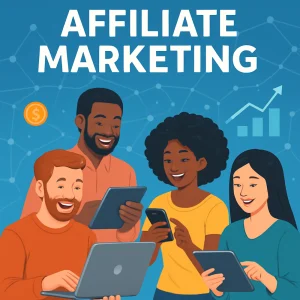Affiliate marketing has become one of the most popular and accessible ways to earn money online. For beginners entering the marketing world, it offers a low-barrier opportunity to learn the ropes of digital promotion while building a potential passive income stream. But like any business model, success in affiliate marketing requires strategy, patience, and consistency.
As a marketing professional observing the shift toward performance-based revenue models, I believe affiliate marketing is not just a buzzword — it’s a real avenue for growth, especially for those who are new to digital marketing. Here’s how beginners can start affiliate marketing the right way, with realistic expectations and a strong foundation.
What Is Affiliate Marketing?
Affiliate marketing is a type of performance-based marketing where individuals (affiliates) earn a commission by promoting someone else’s products or services. You receive a unique affiliate link, and when someone makes a purchase through that link, you earn a percentage of the sale.
In essence, you are helping other businesses make sales and getting paid for every successful referral.
Why Affiliate Marketing Appeals to Beginners
Low Startup Costs
Unlike starting an eCommerce store or launching your own product, affiliate marketing requires minimal upfront investment. You don’t need to create products, manage inventory, or handle customer service.
Flexible and Scalable
You can work on it part-time or full-time, from anywhere with an internet connection. As your experience grows, so can your earnings. Many successful marketers started with affiliate marketing and later branched into other business models.
Valuable Learning Experience
Affiliate marketing forces you to learn about content creation, SEO, analytics, copywriting, and audience engagement. These are foundational skills for any digital marketer.
Looking for a fully managed business opportunity that requires minimal effort?
Step-by-Step Guide to Starting Affiliate Marketing
Step 1: Choose Your Niche
This is arguably the most important decision you’ll make.
A niche is a specific topic area you’ll focus on, such as fitness, finance, parenting, or tech. The narrower and more targeted your niche, the easier it will be to connect with a specific audience.
Tips for Choosing a Niche
-
Passion vs. Profit: Ideally, find a niche that you are passionate about and that has commercial potential.
-
Problem Solving: Choose a niche where you can solve a specific problem for your audience.
-
Market Research: Use tools like Google Trends, Reddit, and keyword planners to gauge interest and competition.
Step 2: Understand Your Audience
Before you promote anything, know who you’re talking to. What are their problems? Where do they hang out online? What content do they consume? Create buyer personas that help you guide your content and product choices.
Step 3: Choose the Right Affiliate Programs
There are three main types of affiliate programs:
1. High-Paying, Low-Volume Programs
These are programs with high commission rates (like web hosting, SaaS, or B2B services) but low conversion rates. Ideal if you’re comfortable creating high-value content and reaching decision-makers.
2. Low-Paying, High-Volume Programs
Amazon Associates is a classic example. You get a small commission, but the trust factor and conversion rates are high. Great for beginners.
3. Recurring Commission Programs
These programs offer recurring payments for subscription-based services (e.g., email marketing tools, CRMs). They provide long-term income if you retain users.

Where to Find Affiliate Programs
-
Affiliate networks like ShareASale, CJ Affiliate, Impact, and Rakuten.
-
Direct from the company’s website under “Affiliates” or “Partner Program.”
-
Content creator marketplaces like ClickBank or Digistore24.
Step 4: Build a Platform
You need a home base for your content — your platform. This is typically a blog, YouTube channel, podcast, or social media page.
Start With a Blog
A blog is still one of the most effective ways to do affiliate marketing. You can write reviews, tutorials, comparisons, and guides — all optimized for search engines.
Why Blogging Works
-
Long-form content builds trust.
-
SEO traffic is free and evergreen.
-
It’s easy to insert affiliate links naturally.
If you’re not a strong writer, YouTube and TikTok are also viable options. Video content often converts better due to visual engagement.
Step 5: Create Valuable Content
Affiliate marketing isn’t about spamming links — it’s about providing value. Your content must help your audience solve a problem or answer a question.
Types of Effective Content
-
Product Reviews: Honest, detailed reviews help consumers make decisions.
-
How-to Guides: Step-by-step tutorials featuring affiliate tools or products.
-
Comparison Posts: Help users decide between Product A and Product B.
-
Listicles: “Top 10 Tools for X” style articles often perform well.
Step 6: Drive Traffic to Your Platform
You can have the best content, but without traffic, it won’t convert. Focus on driving targeted traffic that aligns with your niche.
Free Traffic Sources
-
SEO (Search Engine Optimization): Learn how to optimize content for Google.
-
Pinterest: Great for niches like food, beauty, and home decor.
-
Social Media: Build an audience on platforms like Instagram, X (Twitter), and LinkedIn.
-
Email Marketing: Build an email list early and nurture it.
Paid Traffic (Optional for Beginners)
Google Ads, Facebook Ads, and YouTube Ads can work, but they require a budget and experience in ROI tracking.
Step 7: Optimize and Analyze Performance
Use tools like Google Analytics, Ahrefs, or affiliate dashboards to track:
-
Click-through rates (CTR)
-
Conversion rates
-
Revenue per click
-
Top-performing content
Optimization is ongoing. A/B test different calls to action, images, and headlines. Improve content that underperforms and double down on what works.
Common Mistakes Beginners Make
1. Promoting Too Many Products
Stick to a few quality products. Overwhelming your audience with too many recommendations will dilute trust.
2. Ignoring Disclosures
FTC regulations require you to disclose affiliate relationships. Be transparent — your audience will appreciate it.
3. Not Building an Email List
Email marketing is still the most reliable way to build long-term relationships with your audience and promote products consistently.
4. Expecting Overnight Success
Affiliate marketing takes time. You’re building content, trust, and visibility. Most people don’t see significant income until 6–12 months in.
Final Thoughts: Play the Long Game
Affiliate marketing is one of the most rewarding ways to learn and earn in the digital space, especially for new marketers. But it’s not a get-rich-quick scheme.
Start with a clear niche, serve your audience with authentic content, and stay consistent. Focus on building relationships, not just making sales. Your reputation is your greatest asset in this space.
For marketers looking to get their feet wet or diversify their skillset, affiliate marketing provides a real-world education in digital influence, content strategy, and consumer behavior.
In my opinion, it’s not just a side hustle — it’s a foundational marketing discipline for the future of commerce.
Explore our turnkey business solution designed for aspiring entrepreneurs.
